Edge Computing vs Cloud Computing: A Comprehensive Comparison
In the rapidly evolving world of technology, understanding the differences between edge computing and cloud computing is crucial for businesses and individuals alike. Both technologies play pivotal roles in data processing and storage, but they cater to different needs and scenarios.
What is Edge Computing?
Edge computing refers to the processing of data near the source of data generation, rather than relying on a centralized data-processing warehouse. This approach minimizes latency, reduces bandwidth use, and enhances data processing speeds, making it ideal for real-time applications.
What is Cloud Computing?
Cloud computing, on the other hand, involves the delivery of computing services—including servers, storage, databases, networking, software, analytics, and intelligence—over the Internet ('the cloud') to offer faster innovation, flexible resources, and economies of scale.
Key Differences Between Edge and Cloud Computing
- Data Processing Location: Edge computing processes data locally, near the source, whereas cloud computing processes data in centralized data centers.
- Latency: Edge computing significantly reduces latency, making it suitable for time-sensitive applications. Cloud computing may introduce delays due to data transmission to and from the cloud.
- Bandwidth Usage: By processing data locally, edge computing reduces the need for constant data transmission to the cloud, thereby saving bandwidth.
- Scalability: Cloud computing offers unparalleled scalability options, allowing businesses to easily scale up or down based on demand. Edge computing, while scalable, requires more physical infrastructure to expand.
Choosing Between Edge and Cloud Computing
The choice between edge and cloud computing depends on specific needs. For applications requiring real-time processing and low latency, edge computing is the way to go. However, for scalable, flexible, and cost-effective solutions, cloud computing remains unmatched.
Future Trends
As technology advances, we're seeing a growing trend towards hybrid models that leverage the strengths of both edge and cloud computing. This approach allows for efficient data processing, storage, and analysis, catering to a wide range of applications and industries.
Understanding the key differences between edge computing and cloud computing is essential for making informed decisions that align with your technological needs and goals. Whether it's the speed and efficiency of edge computing or the scalability and flexibility of cloud computing, each has its place in the digital landscape.
